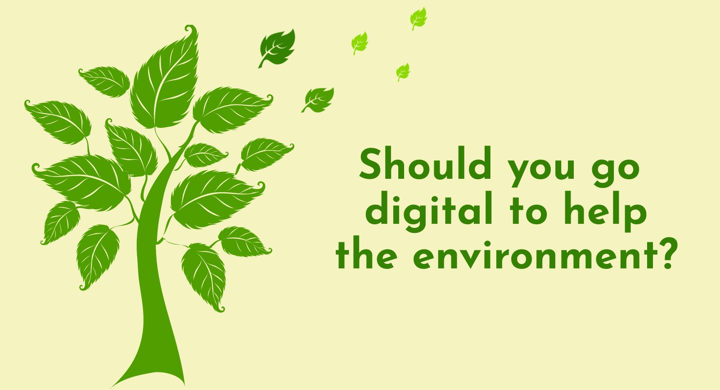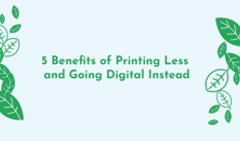Almost every sphere of our lives is full to the brim with paper—from tons of official documentation at work to college papers to even menus in restaurants or brochures on every tourist information stand. All of these documents are printed out, used, discarded, and, if we’re lucky, recycled. If not, they simply turn to waste.
‘Save paper—save trees’ seems like a logical solution to the problem and lots of companies have jumped that wagon recently, claiming going green by going digital. This initiative, though, in many cases is met by one counter-argument: digitalization is not safe for the environment, either.
Which no, it isn’t. Manufacturing electronic devices as well as producing energy to power them leaves a big carbon footprint. Nevertheless, we’ll argue why going digital more and printing less is still a greener option than sticking with paper.
Why Print Less
#1 Responsible printing is not a reality yet
It would be awesome if we all just agreed to print only when absolutely necessary. However, studies show that to this day an average person in the US uses more than 700 pounds of paper per year—more than anywhere else in the world. You would think that with global digitalization paper usage rate should have decreased but actually, the opposite is true: in the last 20 years, the usage of paper products in the US has grown by 126% and in business, it grows roughly by 22% a year.
#2 Recycling rates differ from region to region
Sure, some countries have done well in paper recycling but others are still to catch up. Moreover, even though the US takes fifth place among the world’s top recycling countries, it doesn’t mean the situation here is perfect. Tons of paper products (40-50%) are still sent to landfills instead of being recycled. In fact, if everyone in the US recycled at least one-tenth of their paper waste, the staggering amount of 25 million trees could be saved.
# 3 Deforestation is still a problem
Many rightly believe that, aside from recycling, another efficient solution to the paper waste conundrum is sustainable forest management. However, it is easier said than done. At this point, only Norway has committed to zero deforestation in order to save the remaining rainforests. Overall, in spite of reforestation efforts, worldwide forest loss continues. Of course, there are many factors at play, from logging to wildfires. But at least 10% of deforestation is attributed to the paper industry. How dangerous deforestation actually is to our environment? Specialists say it’s responsible for 12% of greenhouse gas emissions. The warmer it gets, the slower trees grow, and the slower trees grow, the more climate changes. It’s a sort of a vicious cycle. So why contribute to it?
How Going Digital Helps (Among Other Things)
Even though digital solutions are not completely harmless to the environment, we can safely say that neither is printing. Excessive printing certainly does no one any good.
If you and your company really strive to go green and make a change, it should be a thought-through process.
What you can actually do:
- Move at least a part of your documentation, client communication, and marketing collateral digital. An online brochure sent to your customers via a link will certainly be more environment-friendly than dozens if not hundreds of printed leaflets that will turn into trash quicker than you can say ‘green’. And you’ll be able to cut printing and shipping costs as a bonus.
- If you can’t afford to go paperless, try to practice conscious paper usage. Avoid single-use paper packaging. Think twice before printing anything—do you actually need this? Delete extra space, don’t print out an empty “page 2 of 2”. Join the Think Before Printing campaign that encourages putting subtle reminders on documents to prevent unnecessary printing.
- If you want to do more, commit to that wish and do your own research. A lot of non-profit organizations focused on environmental issues develop corporate social responsibility initiatives for future business partners.
See, it’s not that difficult to help. And printing less—or, shall we say, printing smarter—is but a small step to a greener future.
🌳 Not sure where to start?
We have a small green initiative of our own. Get featured on our website and we will plant a tree for you to help global reforestation! Ask us how to participate.





